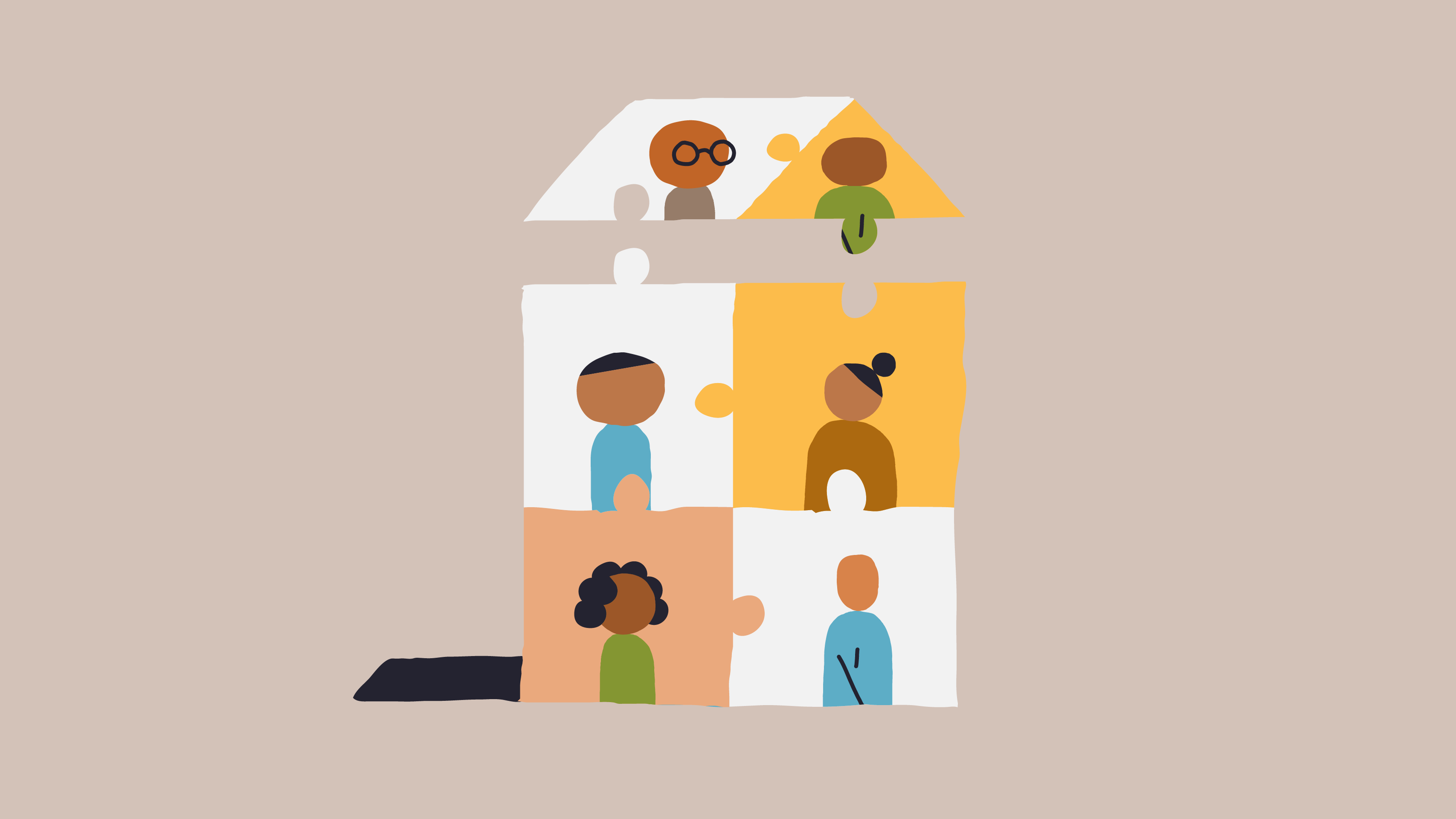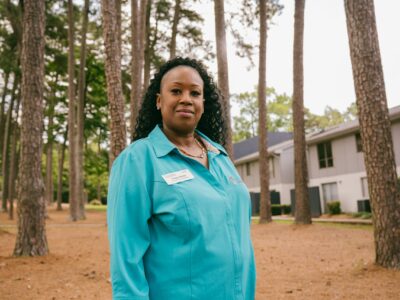Dr. Gerald I.F. Curley, DSW, LMSW, is the Director of Mental Health Homeless Programs and the Mental Health Social Work Authority within VA Detroit Healthcare System in Detroit, Michigan. In his role, Dr. Curley oversees ten programs that support mental health services for veterans who are at-risk of or experiencing homelessness. Those services range from immediate triage and emergent crisis care, all the way through transitional housing and the HUD-VASH permanent supportive housing program.
Inspired by his father who served in the military, Dr. Curley joined VA 11 years ago, starting out with the HUD-VASH permanent supportive housing program and moving up through the ranks as a housing liaison, unit supervisor, and into his current role as program director.
Dr. Curley also serves as a member of Detroit’s Built for Zero improvement team. The community recently achieved a 47% reduction in veteran homelessness on their way to reaching their goal of functional zero for veteran homelessness.
What do you do at your organization?
I work for VA Detroit Health Care System, specifically at the John D. Dingell Medical Center located in midtown Detroit. We have a five-county coverage, with Wayne being the largest where Detroit is situated, but also including Oakland, Macomb, Sanilac, and Saint Clair that surround us.
“I’m really a community organizer at my root, so to me, that’s what we should be doing — getting VA in the community activated together to solve problems.“
Dr. Gerald I.F. Curley
My particular role now is the Director of Homeless Programs here at the facility. We have vocational rehabilitation services and SUD (Substance Use Disorder) Services that are connected to the homeless program. It’s just a very robust, whole-health approach to serving veterans living with mental health illnesses and at risk of or experiencing homelessness. I have about 75 directed and indirect reports across those ten programs who are so super dedicated. I love working with this team.
I’m totally excited because now I get to be intimately involved with the Built for Zero work. I’m really a community organizer at my root, so to me, that’s what we should be doing — getting VA in the community activated together to solve problems. So locally I’m very much involved. I come to the Built for Zero Learning Sessions, I attend the improvement team meetings here locally. I’m part of the veteran leadership committee. I’m part of the GPD (Grant per Diem) Strategy Team. I’m very involved, because I very much believe that the problems are resolved from the people with lived experience and the folks on the frontline working with those folks. And so I really try to lend administrative support to that.
I find that it has really made it real for executive leadership here and throughout the City of Detroit leadership that, because I take that interest in it, it is elevated on their tables. That’s what I love about social work and just this work with homeless and at-risk folks – really getting their voices amplified and finding real, tangible solutions linking VA and community and reducing those silos.
What are you working on right now?
One of the things we’re trying to do with homeless programs is to reduce the barriers between the VA and the community, even looking within our own ten programs. There are unique characteristics to each homeless program, but they really are all one body, one living organism, so I’m really trying to drive that philosophy down through our teams locally.
We had a complete change of leadership in the mental health and homeless programs three years ago. It’s a great time to reshape thoughts, even internally, to mirror what we’ve been doing with the community and with Built for Zero. We want to help folks understand they’re a really valuable part of the equation in their program and within the larger organism that they’re part of, and we need them to show up on that level too.
One of the things I’m really working on is getting everyone to understand each other’s metrics and each other’s goals and objectives and how they all work toward restoring wholeness to the veterans that we serve. Along with that is a focus on leaning into whole health — that our veterans, our patients, are not just homeless or at risk, or have mental health issues, but that they’re complete, whole persons — mind, body and soul.
We’re really trying to right-size the level of administrative and supervisory supports within the homeless program. This work is hard. Part of my championing here at the facility for executive leadership is helping them to understand how we fit into the tapestry of the “classic” kind of medical work. I’m getting them to understand how the work that we do is different, but complementary. If you resolve these things, then you can get folks to be more conscious about their diet and hypertension and diabetes, for example.
We’re really trying to right-size the level of administrative and supervisory supports within the homeless program. This work is hard. Part of my championing here at the facility for executive leadership is helping them to understand how we fit into the tapestry of the “classic” kind of medical work. I’m getting them to understand how the work that we do is different, but complementary. If you resolve these things, then you can get folks to be more conscious about their diet and hypertension and diabetes, for example.
In terms of the community, we’re working with our community providers on identifying new niches of service as we get more efficient and effective at housing and stabilizing veterans. Some of our traditional services are becoming less relevant, and that’s a good thing — i.e. transitional housing. In 2014, we had 384 GPD (Grant per Diem) beds. Starting October 1, we will be down to 80. I’ve really been spending a lot of time mentoring, counseling, coaching, and advising our community partners, particularly the transitional housing providers, to try to find ways forward so that we can all remain relevant and support the population that we also dearly love – veterans.
The other thing that I’m very passionate about is that I will be able to continue being the Director of Mental Health Social Work Education. I love education. So we’ll have an opportunity to shape new social workers that come to VA in this area of work. A lot of folks think they’re going to hang their shingle and do traditional one-hour therapy. But this gives us an opportunity to introduce them to all the community organizing, policymaking, and social welfare administration that exists and that they can be involved in and make differences in, beyond that traditional clinical role.
How is your community working to address disparities within your homeless response system?
It’s been an ebb-and-flow approach. I know in my heart that people understand the importance of it, but it’s so easily eclipsed by things like NOFAs (Notice of Funding Availability) from HUD and then that project gets put on the back-burner. So there’s a renewed commitment now to really being intentional about keeping that forefront.
The city of Detroit actually just launched a collaborative five-year strategic plan with all of us as partners. It’s a first. They’ve invited VA as a federal partner, along with other various nonprofit entities, to sit with a third-party with the objective of ensuring that equality and equity show up in this next plan for the community. I’m glad to see the commitment to sinking consistent teeth into that topic.
In addition to that, all of the Continuums of Care have engaged an opportunity to involve persons of color and persons with lived experience in their boards, on their executive boards, and in their task forces. So there is a renewed commitment now that we’re coming on the other side of the pandemic.
We have director Shawn Liu who is amazing at leading that work for VA. They have done really intentional work nationally through the homeless programs to try to dig into how equity plays into the decisions we make with persons with lived experience, their housing outcomes, and the time they’re homeless. That team goes about it in a really intentional and quantifiable way. It’s not just loft qualitative theories. They produce tangible results as they dig into the root — the bone and marrow of the problem — and confront the systems issues dealing with equity.
Why is improving equity important in your community’s broader efforts to end homelessness?
Whether we want to admit it or not, there are a lot of things that are systemically and institutionally ingrained, and a lot of it inherently and unconsciously happens. A lot of our biases, and not just biases, are unconscious. We could even argue that they’re not intentional, but that’s not a reason to not address them.
I think that’s why it’s so important to intentionally review, at the cellular level as individuals. what our prejudices are, what our dispositions are, and what our natural tendencies and proclivities are, so we can examine how it impacts how we treat those we serve, how we treat those we serve along with.
We see it in the data, that based on those dispositions and postures, a person’s real outcomes — like how long they are in a shelter, for example — can sometimes be drawn back to how you approach that case based on sex, gender, race. That’s why it’s so important to really dig down into and see how that stuff is within us as individuals, as servants, and embedded in our systems, and try to aggressively and intentionally remove it as a barrier.
What do you think people need to understand about unequal access and homelessness?
I think the first thing that folks need to understand is we are all very individual. I often share the story, though I am visibly a Black man. I actually am multiethnic, and I’ve had a privileged background, so when someone turns to me and says, ‘Well, what would Black men who are in your age bracket think, or what do they want?’ I say, well, that’s the first misconception, because we’re not all the same. I own my privilege: a two-parent home, professional, white-collar, grew up in the suburbs, went to a very prestigious private school from kindergarten, all of that.
“We have to realize this work is uncomfortable, because it challenges how we have naturally lived our lives. “
Dr. Gerald I.F. Curley
My experience is very different. Not better than, but different. So if we’re going to really talk about equity for any of the “-isms,” we have to recognize that you can’t identify that one savior, and they’re going to be your answer. We have to get out of that mentality. So that’s the first thing — that each person really does bring their own experience and their own stuff to the picture and not to just generalize based on — well, I’ve got this one example to go from.
I think the other thing is that we have to realize this work is uncomfortable, because it challenges how we have naturally lived our lives. We are socialized the way we’re socialized. We have the experiences that we have good or bad, high or low — we are who we are. We have to be willing to enter into those painful, uncomfortable spaces, and to have those painful and uncomfortable discussions with an open mind.
We need to realize that there may be some things I need to change. or that I need to consider, or at least need to understand how it’s impacting the decisions and actions that I undertake. And so I am really glad to see that there’s intentional time being spent to allow people to just grow comfortable with doing that. It’s not an easy task to peel your own banana and expose yourself. It’s like, OK, I do have some work to do. We ask people to do it all the time as behavioral health professionals, but this is actually our work now, so that we can be more effective in our roles. That’s why it’s so important.
Why do you think homelessness is solvable?
Because we have the resources.
It requires someone to say, alright, I’m not going to allow greed and hoarding and all the other things to allow us to have resources available and not connect them to the people that need them. It’s really a policy shift. It’s a mind shift. It’s a heart shift.
We know, across the land, not just in Detroit, there are plenty of housing, buildings, apartments, that are unoccupied and unused that can be converted in some kind of way, through some kind of law, with some kind of funding, to get individuals who are homeless into them. And it’s just a matter of having the wherewithal, the innovation, and the creativity, and the stick-to-itiveness to find the connections to make that happen.
Is there anything else you’d like to share about yourself and/or your community?
We’re going through a transition, and I just want to double down on how resilient the system has been. The fact that the folks have done the work here in Detroit to examine itself and to continue to do so. That’s how we’re going to solve homelessness. That’s how we’re going to reach functional zero. That’s how we’re going to be able to move the same philosophy to tackle other problems.
Because we are learning in the midst of this how to work together, how to set aside ego and agenda, to point all the work toward where it should be, which is serving our population — veterans.
I think we will all walk away from this experience with the tools that Built for Zero has given us and the work we have done together and take that back to other parts of our lives and use it. There are ways to build fences where it seems like there’s just a cavern and no resources. We’ve done it. I’m just really encouraged by that.
We will see this kind of stuff replicated throughout our community with other populations, other systems — how you get beyond those silos, those safe comfort zones, and start to build community as service providers.






